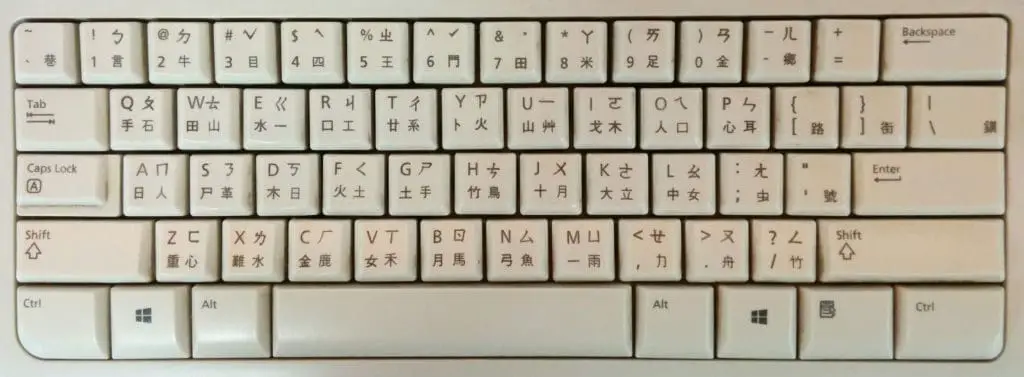When looking at all the different types of keyboards that exist, it is interesting to look at the most extreme opposites of our standard Qwerty keyboard.
The best way to do this is to look at a language such as Chinese that is so vastly different and varied that surely there could be no way for them to express what they are trying to say with our measly 26 letters. Luckily though, there is.
This article will cover why the Chinese keyboard is so very interesting and how exactly it works. By the end, you will almost be ready to type Chinese yourself. Almost.

Table of Contents
What are some complications with the Chinese language when it comes to keyboards?
The biggest complications with the Chinese language when trying to translate it into a usable state for a computer is the detail of their characters, and the amount the language utilizes.
The characters of the English language are not overly complicated. The most complicated letters are arguably Q, K, M, W purely based on keystrokes required.
At most, the English language has a limitation on strokes (3) but could be four depending on how badly your handwriting is!
In Chinese, on the other hand, a single character could have 57 strokes. Just check out the detail of this character, biáng.

Printing these incredibly detailed characters onto your keyboard would be a challenge in of itself.
How many characters are there in the Chinese Language?
The Chinese language is amazing, it is so expressive and detailed that it can be hard to draw direct comparisons to that of our own. Where we combine letters to make words, to make sentences, to make ideas the Chinese language relies on what you might call symbols.
Their characters are so detailed and expressive because each character can represent not just a word but an entire sentence or concept. We would type the word dog, by combining D, O, and G. Whereas in China they would just use the symbol for a dog.
It is cool to compare how both languages express certain concepts, the idea of having to learn so many characters can make learning to read that much harder. It is more difficult to sound out words you don’t know without someone being there to teach you.
The Chinese language is huge. Huge! It has over 56000 characters, more perhaps when you take into account regional differences, etc. They say that you can get by only knowing about 3000. Maybe as many as 4000.
Imagine if someone told you that you must learn 4000 letters in the alphabet. I suppose it is closer to being asked to learn 4000 words. Which is still a huge task.
The problem is, when you are younger, learning 26 letters and then learning to combine them isn’t overly difficult. Almost every child has mastered the alphabet by 3-4 years of age. However, imagine a Chinese child, who is expected to try and learn all of these characters as a base point. It is a very steep learning curve when learning the Chinese language.
English speaking children can generally learn to read at a basic level when they are just a couple of years old, 2-3, since sounding out simple words is so easy once you have mastered the alphabet. However, in China, children often don’t start learning to read until they are 6 or 7 years old.

How many keys does a Chinese keyboard have?
The Chinese keyboard is very similar to ours. Interestingly, most Chinese people use the same standard Qwerty keyboards that we do. They rely on the same 26 letters that we do to try and get their meaning across. Which isn’t an easy task when you are trying to convey one of several thousand characters through a foreign language.
This is quite a problem for China since it makes learning to type and use a computer incredibly difficult for their native citizens. China is a rapidly developing country, so more and more people are being given access to computers.
This is great, except those same people have no idea how to write, read, or sound out English characters. Let alone convert them into readable Chinese.
How do Chinese keyboards work?
Since Chinese keyboards rely on an English input, there is a lot of work that has to go on behind the scenes. There are a few methods of converting English keystrokes into usable Chinese characters.
In some cases, touch screens can be used and a person can draw the character they wish to type. This has some problems of its own, of course. Usually, the keyboard inputs the keystrokes and the computer itself makes the alterations.
There are three main methods, known as Pinyin, Wubi, and lesser-used Zhuyin. Each has its pros and cons, though none are perfect.
| Pinyin | Wubi | Zhuyin |
|---|---|---|
| Qwerty Keyboard | Qwerty Keyboard | Ancient letter/symbol |
| Most common | Fairly Common | Very Niche (Taiwan) |
| very slow | Faster but still slow | Slow |
| Hard for some to do | Steep learning curve | Very hard to use |
The problem mainly comes from native Chinese speakers who have never spoken, read, or heard English words and sounds being written. So phonetically sounding them out on the keyboard doesn’t work.
What is Pinyin?
Pinyin is perhaps the most commonly used technique for typing by Chinese people with some English knowledge. What you would do, is type out the sounding of the word phonetically on your keyboard.
Your computer would then pop up with a list of suggestions of words you might’ve meant, you can then click the one that best matches what you were trying to say.
This has a few problems though, it can be hard for some people to spell phonetically in their language. Let alone a foreign one. It can also be very, very, slow.
For you or I, typing 50 words a minute is seen as an acceptable typing speed. Those 50 words could be made up of 300-600 characters. Someone using this keyboard would be lucky to be able to type 50 characters a minute.
What is Wubi?
Wubi is another commonly used method of typing on a keyboard. Just like the Pinyin keyboard, the Wubi uses the Qwerty layout with a few key changes.
First, the keyboard is segmented into 5 sections. Each section has its form of shorthand to increase the speed of typing.
Just like secretaries and other note takers perfected the use of shorthand to record information quickly, the Wubi method allows you to convey information quickly. The computer then converts it for you.
The Wubi method has some additional markings on each key to indicate extra keystrokes. Different combinations would produce different results.
This is arguably much faster than the Pinyan method since you can type upwards of 160 characters a minute. But, you are required to learn what is almost a whole other language beforehand.
Even after doing so, you would still be typing horrendously slow compared to your English counterpart.
What is Zhuyin?
The final method is a little more niche, as it is almost used entirely by people of Taiwan and Taiwan alone.
The Zhuyin keyboard uses ancient Chinese letters and symbols instead of our Qwerty keys. Those symbols can be combined to create a unique type of alphabet.
It is based on phonetic Mandarin, meaning you are typing the sounds rather than the correct spelling. So long as you still get your message across, what’s the harm?
This form of keyboard is by far the least efficient and hardest to use. But, you would pretty much only use this if you lived in Taiwan.
Not all Taiwanese people use the Zhuyin keyboard, most would use either the Pinyin or the Wubi. But there is a significant portion that does. So it does deserve a mention.
How do Chinese people type? Watch the video!
Will China create some better keyboards?
Hopefully, China will eventually create some comparatively good keyboards for their population to use. But, it seems unlikely. China is always behind in innovation, especially in this area. For a few reasons.
All the initial work into keyboards was done for English speaking people. Furthermore, they have an incredibly difficult task of condensing their language down into a usable format. They would need minuscule keys on the keyboard to fit even a fraction of the quantity needed.
Lastly, China struggles with innovation. Their laws around copyright are basically non-existent. So, the majority of Chinese products are just rip-offs of other countries. Which is neither here nor there.
Why this is so problematic for keyboards, is that no other country has anything to gain by creating a Chinese keyboard. Who would they sell it to? Not china, because they can just legally copy it. So there is nothing pushing anyone to innovate in this area.
Conclusion:
So, hopefully, this has answered any questions you may have had about how Chinese keyboards work. Although they don’t hold up to our Western keyboards, they are still marvelously creative in their use.
It cannot be overstated how difficult it is to innovate in this area. As touch screen technology improves so will customizability, eventually, they may invent some kind of keyboard that holds up to the efficiency and speed of our own. But that won’t be any time soon, sadly.
Until then, Chinese typists will have to make do going at a slower pace.
